Mobiles and Cashew Nuts
Whenever I give a talk on behavioral economics (and sometimes I feel that is all I do!), I always tell the story of Richard Thaler and the big bowl of cashew nuts. Tim Harford interviewed Richard Thaler for the excellent Lunch with FT series, and while the restaurant they were at didn't serve a bowl of cashew nuts, alas, they did serve almonds.
And so an excellent story was (re)born:
He served the notorious bowl to some guests while dinner was roasting in the oven, then watched everyone compulsively munch on the nuts and gradually spoil their appetites. So Thaler decided to remove the temptation by hiding the cashews in the kitchen. His guests thanked him.
It would be an unremarkable tale, except that such behaviour simply does not fit the rational economic model of human behaviour. Either eat the cashews or don’t eat the cashews, says classical economics, but don’t thank the person who moves them out of easy reach.
Reflecting on such stories helped Thaler create “behavioural economics” — a branch of the discipline that aims at psychological realism. Doing so also helped him with the equally difficult task of persuading other economists to take the behavioural view seriously.
Either eat the cashews or don't eat them. And certainly don't thank the person who moved them out of easy reach.
But that's cashews. What about mobile phones?
Here’s how it works: Once guests arrive at a show and present their tickets, Yondr workers or venue personnel ask them to silence their phones and place them in Yondr pouches. The staffers snap the bags shut, and guests take them inside.
Devices can still receive calls and messages, but to check them, guests have to step outside the venue or go to a cordoned-off phone-use area to have the bag unlocked. After the event, staffers quickly unlock and collect bags as guests exit."
"Two schools in Torrington, Conn., started using Yondr bags a couple of years ago, paying $60,000 to use the pouches for roughly 2,000 students."
Of course I visited the Yondr website. Who wouldn't? Whereupon I discovered that there is now (of course there is) a Yondr tray for home.
What is a Yondr tray for home? Well, it is a tray in which you can keep your phone, and then you can lock the tray. So a box, really, and not a tray. A box tray, note, with all these features:
And how much does this tray cost? $249. Or if you prefer Indian currency, about twenty thousand rupees, give or take.
Truly remarkable, the power of commitment devices and behavioral economics. Also truly remarkable? Smartphones, and the impact they have upon us.



